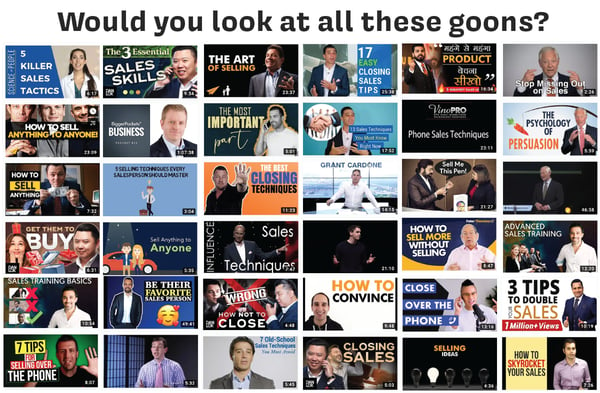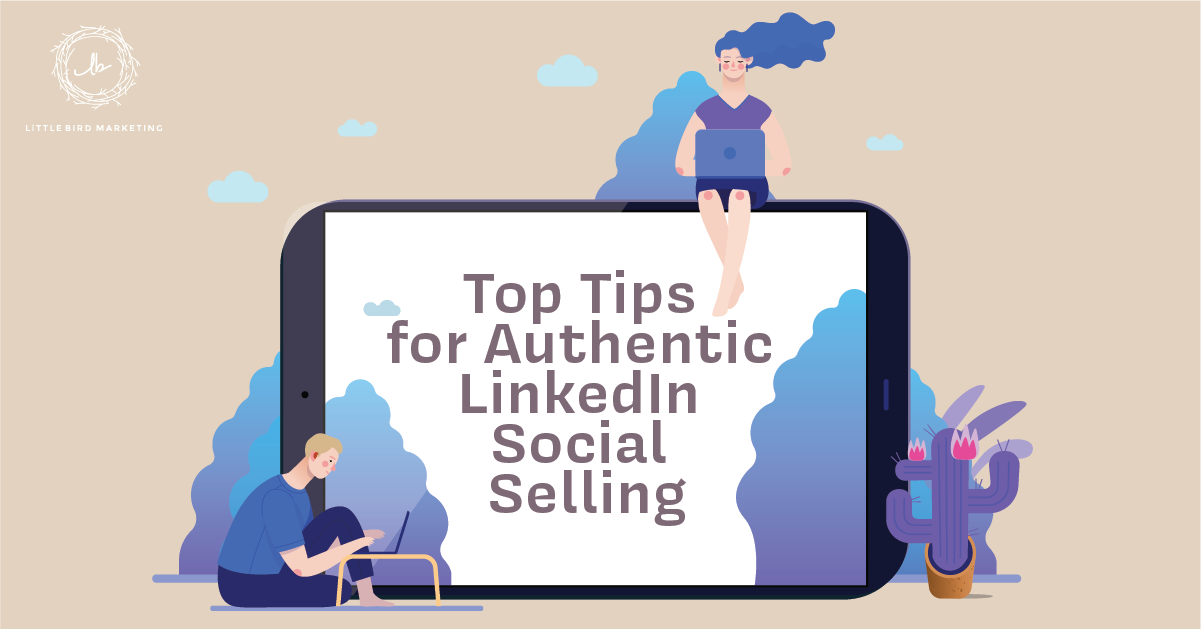The world of sales is a confusing place. Did you ever notice that there is an ever-growing mountain of websites, blogs, YouTube videos, books and courses devoted toward “winning sales tactics,” “groundbreaking sales mindset shifts,” and “innovative sales strategies?” Did you ever wonder what the reason was behind that? 
That's just the first couple pages of YouTube results.
Some of you probably already know the reason: Sales can be hard. But it doesn’t have to be as hard as we make it sometimes. That mountain of resources is a testament to the fact that we have collectively overthought the topic. Indeed, beyond even in-person sales, social networks like LinkedIn and their capacity as sales vessels has added layers of complication. Those can usually be spread out to two broad categories; perception and reality.
Let’s look closer at both of those, and let’s start with the shorter one: REALITY.
This can literally just be a quick aside. It’s that simple. To the person who says, “I have trouble selling because I’m not confident in the product/service I’m trying to sell,” - Get confident in it, or stop selling it.
If you’re having trouble selling something because you aren’t familiar with it, GET FAMILIAR WITH IT. If you’re having trouble selling something because you know it’s crap and you don’t stand behind it, STOP NOW. That’s all. It really is that easy, and it takes a minute to think about where the sticking point is for you.
Now, on to the trickier beast: PERCEPTION.

Analysis paralysis - also oddly reminiscent of a George W. Bush painting
Our perception of ourselves, and our anticipated perception by others is a huge stumbling block for sales. Think about it in the non-internet context. People who are successful in sales are confident, but not pushy. They dress nicely. They’re polite. They’re helpful. They don’t sweat profusely and mutter under their breath. There are direct correlations in social selling on LinkedIn. No, nobody can see you sweating through the computer screen, but the same nervousness that makes you sweat in person is transmitted through your online behavior.
To keep this limited,
here are some common complaints:
1. Social selling just isn’t the same as selling face-to-face.
2. I’m sharing these sales posts, and they’re just getting ignored.
3. I don’t like sales because it makes me feel/look like a sleaze.
4. I don’t like sales because I feel like I’m bothering people.
These are typical concerns that come up during LinkedIn strategy meetings. We can address them one at a time, looking through the lens of social selling on LinkedIn.
 Behold the buyer in their natural habitat, researching and refining their search, and rejecting all cold-calls.
Behold the buyer in their natural habitat, researching and refining their search, and rejecting all cold-calls.
1. Social selling is not at all the same as selling face-to-face.
This is irrefutable. The world has shifted, and consumer behavior is not the same as it was even 10 years ago. For instance, the typical consumer, in today’s marketplace, is already over halfway through their buying process before they contact a sales person. People are now accustomed to doing the cursory research themselves. They know what they’re looking for. That’s part of why they don’t want those cold calls, trying to set up appointments to sell them stuff. In fact, 90% of B2B decision makers won’t even respond to cold outreach, according to Harvard Business Review.
Connections, however, are still important - as with face-to-face selling. That’s where social media fills the gap. LinkedIn has found that 81% of buyers are likely to engage with brands that have a solid presence on social media and 92% of B2B customers are more likely to engage with industry thought leaders. How do you prove you’re an industry thought leader? Consistently post quality, helpful, engaging content, and interact with other industry thought leaders meaningfully.
Don't base your social communication on any part of Plankton's marketing plan.
2. If your sales-related posts are getting ignored, it’s probably strategy-related.
There are two things. First, nobody is going to want to interact with you if the only thing you ever post is a direct sales call. Social media platforms are communities. Imagine, in the real world, that once a month you walk out your front door, loudly shout something about a product to the community at large, then walk back in the house and close the door. You wouldn’t do that, because it would be silly, right? Just because the network contains some businesses that might be interested in your product or service, does not mean that they’re watching your every move.
Secondarily, it’s worthwhile to have a passing knowledge of the algorithms driving the visibility of posts on your social networks of choice. Did you know that posting at the same time every day makes LinkedIn think you’re a robot? You know what LinkedIn thinks of robots? They don’t like them, and they suppress their content. Each post is passed through a multiple step process that evaluates the quality and relevance of not only the post itself, but weighs it against your connections and activity to ensure that it’s valuable. If it’s not determined to be valuable, not very many people will even see it. LinkedIn has a host of profile review tools, including the Social Selling Index, that can help you understand how well you’re doing by their standards. 
"Today is your lucky day!"
3. You don’t have to go into sleazy-salesman-mode just because you’re selling something.
Promise. It’s not a requirement. When people see you walking around the corner with that plaid suit on, carrying an “everything must go” sign, they turn around and run like you were Pennywise, or someone getting ready to crack open a durian. Even people who are on board for a pitch, or interested in your service aren’t looking for a high pressure sales environment like that. So, if you don’t want to feel like a sleaze, don’t be a sleaze. That’s a pretty easy fix, actually. Instead, focus on how whatever it is you’re selling is actually helpful. Explain it. Better yet, show it. If you want to see some examples of how this is done, just check the #alwaysbehelping hashtag on LinkedIn. 
"Hold on a second, I don't want to be bothersome."
4. Always be helping. Especially when people need help.
We have already covered most of the fear of being bothersome above, but, there is a distinction that still warrants its own small footprint here. The initial response to the recent/ongoing pandemic saw most businesses facing at least minor meltdowns in terms of what they should actually be doing. The necessity of adaptation, relying on unfamiliar technology, and general confusion about the best way forward drove this confusion. And yet, some businesses who had perfectly good solutions in their back pockets - instead of using that opportunity to share how they could help - froze.
“There’s a lot going on right now,” they said. “We don’t want to be a bother.” OK, fair. That’s valid. But - it’s also kind of like, “Why’s that candle under that bushel basket?” Being connected with your network means that you are interacting with peers. You understand at least some of their pain points. Those peers might benefit from what you do. If you approach a situation genuinely, with the best of intentions, offering to help - even in the form of a service you’re selling, it’s not going to be a bother. Promise.
Speaking of which, if you need help understanding and developing a strategy for social selling, check this out.
Our 12-week, skill transformation modules instill the needed mindset shift and technical skills tocreate huge efficiencies and codify what it takes to generate leads and drive revenue through
social media efforts.








Let Us Know What You Thought about this Post.
Put your Comment Below.